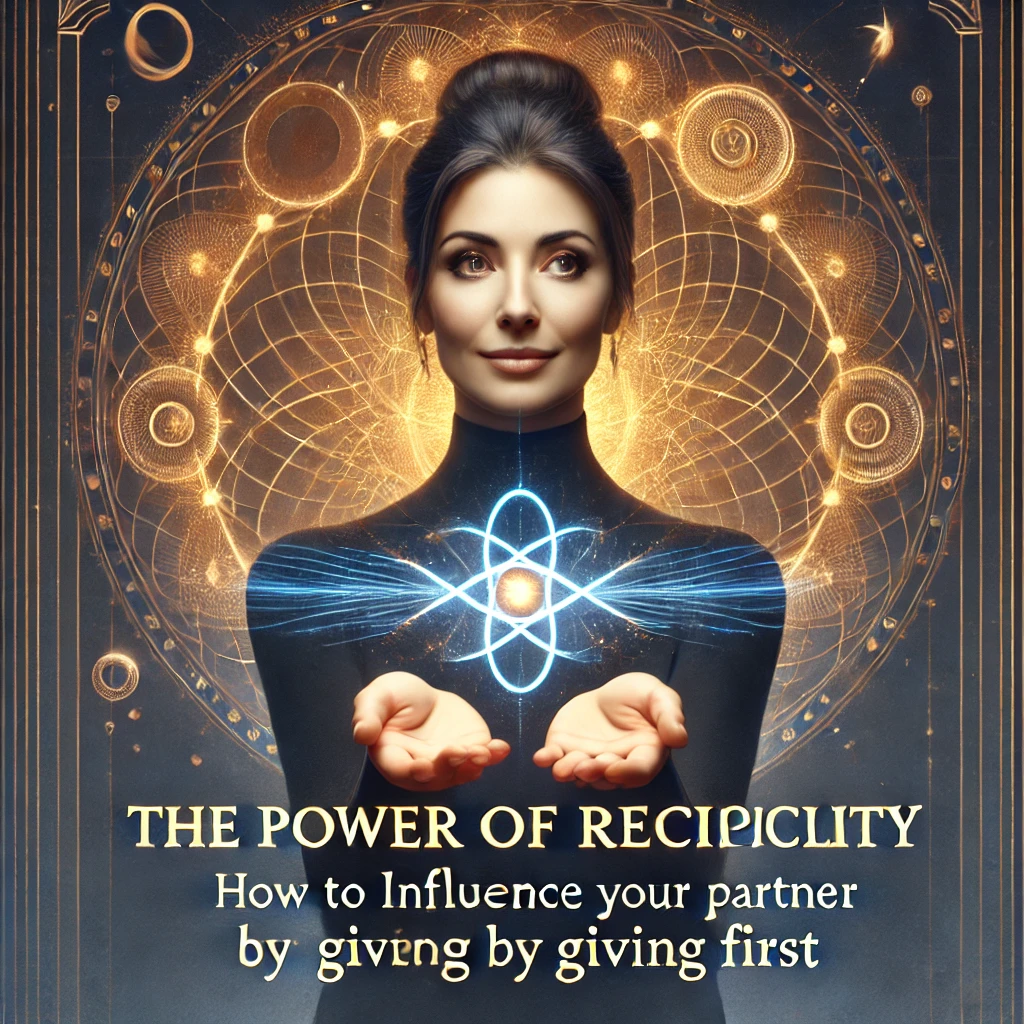In every relationship, the balance of give and take shapes the dynamics. When one person consistently gives more, they can feel drained, while the other might feel comfortable or even complacent. But here’s where it gets interesting: you can use The Power of Reciprocity to influence your partner’s behavior in a way that makes them more responsive to your needs—all while creating a harmonious balance in the relationship.
Reciprocity is a psychological principle that drives people to return favors, making it a subtle yet powerful tool for influencing your partner. It’s not manipulation; it’s about creating a positive exchange where both of you benefit. The beauty of this approach is that it doesn’t rely on confrontation or demands—just simple acts of kindness that lead to your partner wanting to give back.
In this blog, we’ll dive deep into The Power of Reciprocity, explore how it works in relationships, and look at some real-life examples that show how giving first can help you influence your partner and create a healthier, happier relationship.
What Is The Power of Reciprocity?
Reciprocity is the social norm of responding to a positive action with another positive action. In other words, when someone does something nice for you, you feel a natural inclination to return the favor. It’s human nature—people want to keep things balanced, and when they receive something, they feel compelled to give something in return.
In relationships, reciprocity can be a powerful tool for influence. By giving first—whether it’s emotional support, acts of kindness, or small favors—you create a sense of goodwill and encourage your partner to reciprocate. The key is to give genuinely, without expecting an immediate return. Over time, the natural balance of reciprocity will lead your partner to want to do more for you in return.
Why Does Reciprocity Work in Relationships?
The Power of Reciprocity works because it taps into our innate desire for fairness and balance. No one wants to feel like they’re in a one-sided relationship. When your partner receives acts of kindness or support from you, they unconsciously feel the need to return the favor, restoring balance in the relationship.
In a relationship, this balance creates mutual satisfaction and strengthens the bond between partners. When you give first, you set the tone for generosity, care, and cooperation. And the best part? When your partner reciprocates, they’re doing so because they genuinely want to, not because they feel forced or coerced.
How to Use The Power of Reciprocity in Relationships
Let’s look at some practical examples of how you can use reciprocity to influence your partner in everyday situations.
Example 1: Encouraging More Affection
You’ve noticed that your partner hasn’t been as affectionate lately, and you want to encourage more physical closeness and emotional connection. Instead of asking directly, you can use reciprocity to influence their behavior.
How to Use Reciprocity:
Start by giving affection without asking for anything in return. Give them a long hug when they come home, hold their hand while watching a movie, or offer a spontaneous kiss. Over time, these small acts of affection will make your partner feel more loved and appreciated, which will encourage them to reciprocate by showing more affection toward you.
Why It Works:
When you give affection freely, your partner feels more secure and valued in the relationship. This positive emotional reinforcement makes them more likely to give affection back, creating a natural cycle of warmth and closeness.
Example 2: Getting More Help with Household Chores
If you’ve been doing the majority of the household chores and want your partner to pitch in more, reciprocity can help shift the balance without leading to arguments or frustration.
How to Use Reciprocity:
Instead of pointing out that your partner isn’t helping, start by doing something thoughtful for them—like taking care of a task they normally handle, or making their morning coffee. Then, casually mention how good it feels to share responsibilities and express appreciation for the things they do. This act of generosity can spark a sense of reciprocity in your partner, motivating them to help out more with the household tasks.
Why It Works:
By taking the lead in showing generosity and acknowledging their contributions, you create an atmosphere of cooperation. Your partner will feel the need to balance the effort by helping out more, leading to a more equal division of household responsibilities.
Example 3: Fostering Better Communication
If you feel like your partner hasn’t been as communicative or open lately, you can use reciprocity to encourage more meaningful conversations without pushing them.
How to Use Reciprocity:
Start by being an active listener when your partner speaks, showing genuine interest in what they’re saying. Ask thoughtful questions and show empathy when they share their thoughts or concerns. Over time, this approach will lead your partner to reciprocate by being more open and communicative with you, as they’ll feel heard and valued.
Why It Works:
When you give the gift of listening and emotional support, it encourages your partner to do the same. People are naturally more willing to communicate when they feel like they’re being understood, which leads to better and deeper conversations in the long run.
Example 4: Creating More Quality Time Together
You’ve been craving more quality time with your partner, but they seem distracted or preoccupied. Rather than demanding their attention, reciprocity can be used to shift their focus back toward spending time with you.
How to Use Reciprocity:
Plan a thoughtful activity or surprise for your partner that aligns with their interests—whether it’s cooking their favorite meal, organizing a fun outing, or setting up a relaxing night in. By taking the initiative to create quality time for them, your partner will start to feel appreciated and will naturally want to return the gesture by spending more time with you.
Why It Works:
When your partner sees that you’re making an effort to prioritize their happiness, they’ll feel more inclined to do the same for you. Reciprocity fosters a sense of gratitude and togetherness, making it easier to nurture quality time without forcing the issue.
Why Reciprocity Is Better Than Direct Requests
One of the greatest advantages of using The Power of Reciprocity is that it’s more subtle and less confrontational than direct requests. Asking your partner for something directly—whether it’s help, affection, or time—can sometimes feel like a demand, which may lead to defensiveness or resistance. But with reciprocity, the exchange is natural and voluntary.
When your partner feels like they’re giving back out of their own volition, it creates a stronger emotional connection. There’s no resentment or sense of obligation because the act of reciprocating feels good. Reciprocity works because it’s based on genuine appreciation and balance, not guilt or pressure.
Practical Tips for Using The Power of Reciprocity
Here are some additional tips for mastering the art of reciprocity in your relationship:
- Give Without Expecting Immediate Return: The key to making reciprocity work is patience. Don’t give with the expectation of an immediate return. Trust that your partner will naturally reciprocate in their own time.
- Be Consistent: Small, consistent acts of kindness are more powerful than grand gestures. Over time, these little moments of giving will create a stronger bond of reciprocity.
- Be Genuine: Make sure that your acts of generosity come from a place of genuine care. If your partner senses that you’re only giving to get something in return, the power of reciprocity will be lost.
- Appreciate the Little Things: Acknowledge when your partner reciprocates, no matter how small the gesture. Showing appreciation reinforces the positive cycle of giving and encourages more reciprocity in the future.
Q&A:
- What is the power of reciprocity in relationships, and how does it work?
Reciprocity in relationships is about creating a balance of give and take. When you give—whether through support, kindness, or small favors—your partner naturally feels inclined to give back. This technique fosters harmony without pressuring them, as they respond to your actions out of a desire to reciprocate. - How can I use reciprocity to influence my partner’s behavior?
Start by giving first in areas you’d like to see improvement in, like affection or quality time. For example, showing affection or planning a special date makes your partner feel appreciated, encouraging them to return the favor. By giving first, you lead by example, making it more likely they’ll reciprocate. - Why is reciprocity more effective than asking directly in relationships?
Reciprocity avoids the pressure or defensiveness that direct requests can create. Instead, it fosters natural cooperation because your partner feels appreciated and motivated to reciprocate, creating a voluntary, positive cycle without feeling obligated. - Can reciprocity help improve communication in my relationship?
Yes! By actively listening, showing empathy, and being supportive, you create a safe space where your partner feels understood. Over time, they’re likely to reciprocate by being more open and communicative with you, leading to deeper, more meaningful conversations. - How can I use reciprocity to encourage my partner to help with household chores?
Do something thoughtful for your partner, like handling a task they usually manage or preparing their favorite breakfast. Then, express how nice it is to share responsibilities. This act of kindness can motivate them to reciprocate by contributing more to the household chores. - What are some examples of using reciprocity to influence your partner?
- Encouraging affection: Start by showing small, consistent acts of affection without asking for it in return.
- Quality time: Plan a fun or thoughtful activity to show you value their presence, and they’re likely to return the gesture.
- Household help: Handle tasks that lighten their load, sparking a desire in them to pitch in more.
- Why does reciprocity help create a stronger bond in relationships?
Reciprocity builds a sense of mutual appreciation and balance. When you give genuinely and see your partner respond by giving back, it strengthens the emotional connection and creates a more harmonious relationship dynamic. - Can reciprocity work for creating more quality time with my partner?
Absolutely. Organize a special activity or date that aligns with their interests to show you value time together. When you prioritize them, they’re likely to reciprocate by seeking more quality time with you in return. - What are some common mistakes to avoid when using reciprocity?
- Expecting instant return: Patience is key; give without expecting an immediate response.
- Insincerity: If it feels transactional, reciprocity loses its effect. Be genuine in your acts of kindness.
- Overdoing it: Keep gestures balanced and sustainable to avoid feeling drained.
- How can I practice reciprocity consistently in my relationship?
Incorporate small, meaningful acts of giving regularly, such as listening intently, expressing appreciation, or taking over a small task. Recognize and appreciate your partner’s efforts when they reciprocate, reinforcing the positive cycle of giving and mutual support.
Want to Master The Power of Influence in Your Relationship?
If you’re ready to take your influence to the next level, “Mastering Him: The Secret Art of Gentle Control in Relationships” is the guide you’ve been waiting for. In Chapter 5, you’ll dive deeper into The Power of Reciprocity and learn how to use this technique—along with 12 other powerful strategies—to subtly guide your relationship in the direction you want.
Get your copy today and start mastering the art of influence in your relationship. It’s time to stop pushing for change and start creating a dynamic where your partner naturally wants to give back.
Read more about the book: https://developmentpill.com/mastering-him-the-secret-art-of-gentle-control-in-relationships-a-guide-to-influence-hell-never-see-coming/
Book Link: https://www.amazon.com/dp/B0DKKGLZQ9
Book Link UK: https://www.amazon.co.uk/dp/B0DKKGLZQ9
You can find book Links for other regions in this post page: https://developmentpill.com/mastering-him-the-secret-art-of-gentle-control-in-relationships-a-guide-to-influence-hell-never-see-coming/



